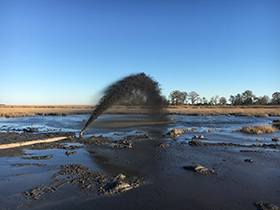A critical Maryland marshland project that provides habitat for the American Bald Eagle, as well encompasses the Harriet Tubman Underground Railroad National Historical Park, was honored with an esteemed climate change adaptation award — thanks in part to U.S. Army Corps of Engineers’ dredging expertise.
The Blackwater National Wildlife Refuge Marsh Resiliency project was awarded runner-up in the 2017 American Society of Adaptation Professionals Prize for Progress in Adapting to Climate Change awards, based on its effectiveness, significance and innovation.
According to ASAP, "the promising practices from these models will provide guidance and encouragement for other communities…and will help celebrate progress in an emerging field and strengthen the professional foundations of current climate adaptation efforts."
Rising sea levels threaten the marsh ecosystem and critical bird habitat on the Blackwater refuge, which resides in Dorchester County on the Eastern Shore.

A thin layer of material dredged from Blackwater River is sprayed across deteriorating marsh on the Blackwater National Wildlife Refuge in Dorchester County, Maryland. (Courtesty photo)
The Conservation Fund, who is the lead organization for the project, approached the Corps Baltimore District more than a year ago about offering technical advice as part of an interagency adaptation project on 40 acres of declining marshland on the refuge. The Fund secured money through the National Fish and Wildlife Foundation’s Hurricane Sandy Coastal Resiliency Grant Program, and the district was able to join the project team that also includes the U.S. Fish and Wildlife Service and the Audubon of Maryland and the District of Columbia.
The goals of the project include slowing the rate of marsh loss through targeted enhancement and restoration, enhancing high-quality native vegetation and conserving undeveloped habitat in bird-migration corridors.
"This project presented a unique way to partner with a non-governmental agency and is also a great example of how the Corps can fulfill a unique niche in a partnership," said Amy Guise, Baltimore District, Planning Division chief.
As part of this project, a thin layer of material dredged from the nearby Blackwater River was sprayed across deteriorating marsh surface to increase the marsh’s profile and enable more resilient native plants in the face of rising seas, and, therefore, create a more sustainable bird habitat.
Baltimore District provided information on previous thin-layer dredged material placement at the refuge that was completed around 2003.
"Using what was accomplished in that demonstration helped outline what works and what doesn’t," said Danielle Szimanski, Baltimore District, Navigation Branch project manager. "My team provided a fair amount of background on how to set up a contract, as well as information on dredging plans, equipment and pumping specifications."
The final phase of work on this project is underway, and the refuge is one step closer to becoming a living laboratory. A team of native plant installers is placing Spartina patens plugs in an elevated but undeveloped portion of the refuge. Data from this project will be included in the Salt Marsh Habitat and Avian Research Program that examines adaptation strategies on at-risk birds.
"My thanks to our project team members for their expertise and dedication and to our agency friends for their active support and assistance," said Erik Meyers, The Conservation Fund, Climate and Water Sustainability vice president. "At completion, nearly a quarter million plants will help this site fully rejuvenate. I have already noticed birds active across the site, appreciating the renewed marsh."